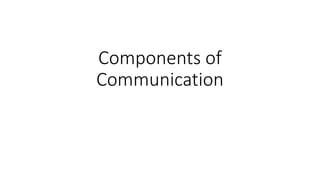
Components of communication.pdf
- 2. Sending and De-coding messages • Communication can best be summarized as the transmission of a message from a sender to a receiver in an understandable manner. • The importance of effective communication is immeasurable in the world of business and in personal life. • From a business perspective, effective communication is an absolute must, because it commonly accounts for the difference between success and failure or profit and loss. 2
- 4. • The communication process is made up of following key components. • These components include; Sender Encoding Medium of transmission Receiver Decoding Feedback Context 4
- 5. Sender • The sender is an individual, group, or organization who initiates the communication. • This source is initially responsible for the success of the message. • The sender's experiences, attitudes, knowledge, skill, perceptions, and culture influence the message. • ‘The written words, spoken words, and nonverbal language selected are paramount in ensuring the receiver interprets the message as intended by the sender’. • All communication begins with the sender. 5
- 6. Encoding messages • The first step the sender is faced with involves the encoding process. • In order to convey meaning, the sender must begin encoding, which means translating information into a message in the form of symbols that represent ideas or concepts. • This process translates the ideas or concepts into the coded message that will be communicated. 6
- 7. Contd. • The symbols can take on numerous forms such as, languages, words, or gestures. • These symbols are used to encode ideas into messages that others can understand. • When encoding a message, the sender has to begin by deciding what he/she wants to transmit. 7
- 8. Medium • To begin transmitting the message, the sender uses some kind of channel (also called a medium). • The channel is the means used to convey the message. • Most channels are either oral or written, but currently visual channels are becoming more common as technology expands. • Common channels include the telephone and a variety of written forms such as memos, letters, and reports. 8
- 9. Contd. For example, when immediate feedback is necessary, oral communication channels are more effective because any uncertainties can be cleared up on the spot. In a situation where the message must be delivered to more than a small group of people, written channels are often more effective. Although in many cases, both oral and written channels should be used because one supplements the other. 9
- 10. Contd. The sender should ask him or herself different questions, so that they can select the appropriate channel. Is the message urgent? Is immediate feedback needed? Is documentation or a permanent record required? Is the content complicated, controversial, or private? Is the message going to someone inside or outside the organization? Once the sender has answered all of these questions, they will be able to choose an effective channel 10
- 11. Receiver • Individual or individuals to whom the message is directed • can communicate either verbally or non-verbally • The degree to which the decoder understands the message is dependent upon various factors such as knowledge of recipient, the relationship and trust that exists between sender and receiver etc. • make excellent eye contact, listen carefully and sit up straight. • focus on the message 11
- 12. De-coding • After the appropriate channel or channels are selected, the message enters the decoding stage of the communication process. • Decoding is conducted by the receiver. • Once the message is received and examined, the stimulus is sent to the brain for interpreting, in order to assign some type of meaning to it. • The receiver begins to interpret the symbols sent by the sender, translating the message to their own set of experiences in order to make the symbols meaningful. 12
- 13. Feedback • Response, reaction, or information given by the recipient of a message to the sender • Allows the sender to evaluate the effectiveness of the message. • May take the form of a spoken comment, a long sigh, a written message, a smile, or some other action. • Even a lack of response, is in a sense, a form of response 13
- 14. Context • Broad field that consists of different aspects (country, culture, organization etc.). • Involves the setting, scene, and expectations of the individuals • Opinions, attitudes, likes, dis-likes, emotions, experience, education and confidence • Physical location and characteristics, the culture associated with the communicators, the relationships between communicators, and the expected behavior based on past behaviors can influence communication. 14